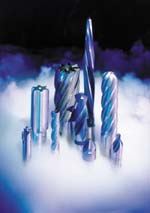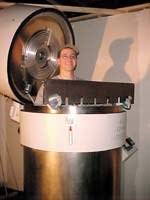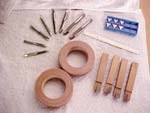Bringing Cryogenics In From The Cold
There are numerous cases of significantly improved performance from steel and carbide cutting tools that have undergone cryogenic (deep freeze) treatment. But wide use of the process seems to suffer from a perceived lack of scientific underpinnings.
Share




Hwacheon Machinery America, Inc.
Featured Content
View More




There are numerous cases of significantly improved performance from steel and carbide cutting tools that have undergone cryogenic (deep freeze) treatment. But wide use of the process seems to suffer from a perceived lack of scientific underpinnings. While it’s not uncommon in metalworking to have complete understanding of the science of a process lag behind observing the results, this has tended to slow widespread use of cryogenics. The fact is cryogenic treatment works in many applications, but only now are we starting to understand why.
Heat treatment of steel involves the transformation from its softer more malleable annealed state to a harder more durable state. This is done, as it has been for centuries, by heating the steel and then rapidly cooling it. The result is a harder and more wear resistant object. The metallurgical reason for this is that as the steel is heated, it forms an austenite crystal structure or matrix. Rapidly cooling or quenching the steel (traditionally at room temperature) triggers some of the austenite structure to change into a different matrix called martensite. It’s the martensite structure that gives tempered steel its hardness and wear resistance for applications from cutting tools to punch dies.
The goal of heat treatment then is to transform as much of the austenite as possible into martensite. However, some of the austenite is retained even after tempering. Through experiments it was found that if the quench was lower than the traditional room temperature, less austenite was retained. Cryogenic treatment is an extension of the well-known heat and quench cycle. It is specifically about controlled thermal cycling of materials from +300°F to -300°F generally over a 15 to 30 hour period of time.
But, according to Dr. Jeff Levine, founder of Applied Cryogenics in Waltham, Massachusetts, this reaction alone (which has been understood for some time) doesn’t explain all of the results that cryogenically treated materials display. For example non-ferrous materials, copper, brass and even plastics show improved performance after being submitted to the cryogenic process. These materials don’t have austenite or martensite structures. Something else is going on.
Recently, David Collins at University College in Dublin, Ireland, has done research on cryogenic processing. In addition to the well known transformation of retained austenite to martensite, Mr. Collins has identified another important mechanism at work in cryogenic treatment. He has found that beyond the chemical change from austenite to martensite, some carbon precipitates out of these existing matrices when the material is cooled below the temperature where the change takes place. This distribution of carbide fines occurs slowly at very low temperatures and is time dependent. His direct measurements demonstrate that the density of these new carbides increases with the dwell time at the low temperatures. As carbide density increases, abrasive wear resistance increases. The experiments also show that colder is better so the cryogenic process, which once used dry ice to achieve -80° to -100°F tempering, is now using liquid nitrogen to get down to -300° temperatures. Better, more consistent results are being achieved at these very low temperatures.
As for the effects of cryogenics in non-ferrous materials, Dr. Levine postulates that in addition to the chemical changes of deep freezing, some of the residual stresses, which are found in the microstructure of all materials, seem to be reduced by the cryogenic process. While this is yet to be conclusively proved by experimentation, it is strongly supported by empirical data gathered in applications. Dr. Levine’s hope is that research supported by industry and academia, along the lines of Mr. Collins’ work, can shed more light on the residual stress question.
Science not withstanding, it is results that interest shops in new processes. There are numerous cases of significantly improved performance of steel and carbide cutters that have been cryogenically treated. The process is cost effective and has worked wonders in many applications. The goal of Dr. Levine and others in this industry is to help disseminate understanding of the process so the results are consistent and predictable. “We want to take the “black magic” out of cryogenics and replace it with understanding,” says Dr. Levine.
Related Content
How to Mitigate Chatter to Boost Machining Rates
There are usually better solutions to chatter than just reducing the feed rate. Through vibration analysis, the chatter problem can be solved, enabling much higher metal removal rates, better quality and longer tool life.
Read MoreSelecting a Thread Mill That Matches Your Needs
Threading tools with the flexibility to thread a broad variety of holes provide the agility many shops need to stay competitive. They may be the only solution for many difficult materials.
Read MoreOrthopedic Event Discusses Manufacturing Strategies
At the seminar, representatives from multiple companies discussed strategies for making orthopedic devices accurately and efficiently.
Read MoreFinding the Right Tools for a Turning Shop
Xcelicut is a startup shop that has grown thanks to the right machines, cutting tools, grants and other resources.
Read MoreRead Next
Registration Now Open for the Precision Machining Technology Show (PMTS) 2025
The precision machining industry’s premier event returns to Cleveland, OH, April 1-3.
Read More5 Rules of Thumb for Buying CNC Machine Tools
Use these tips to carefully plan your machine tool purchases and to avoid regretting your decision later.
Read MoreBuilding Out a Foundation for Student Machinists
Autodesk and Haas have teamed up to produce an introductory course for students that covers the basics of CAD, CAM and CNC while providing them with a portfolio part.
Read More







































.png;maxWidth=300;quality=90)


.jpg;maxWidth=300;quality=90)








